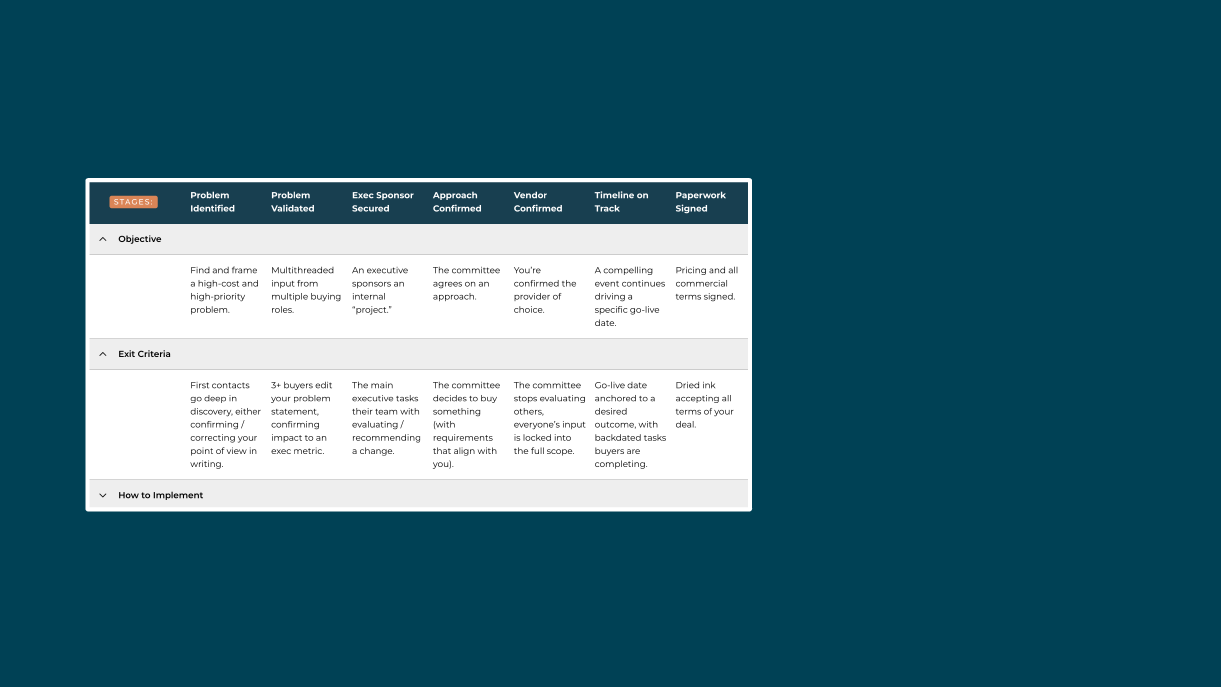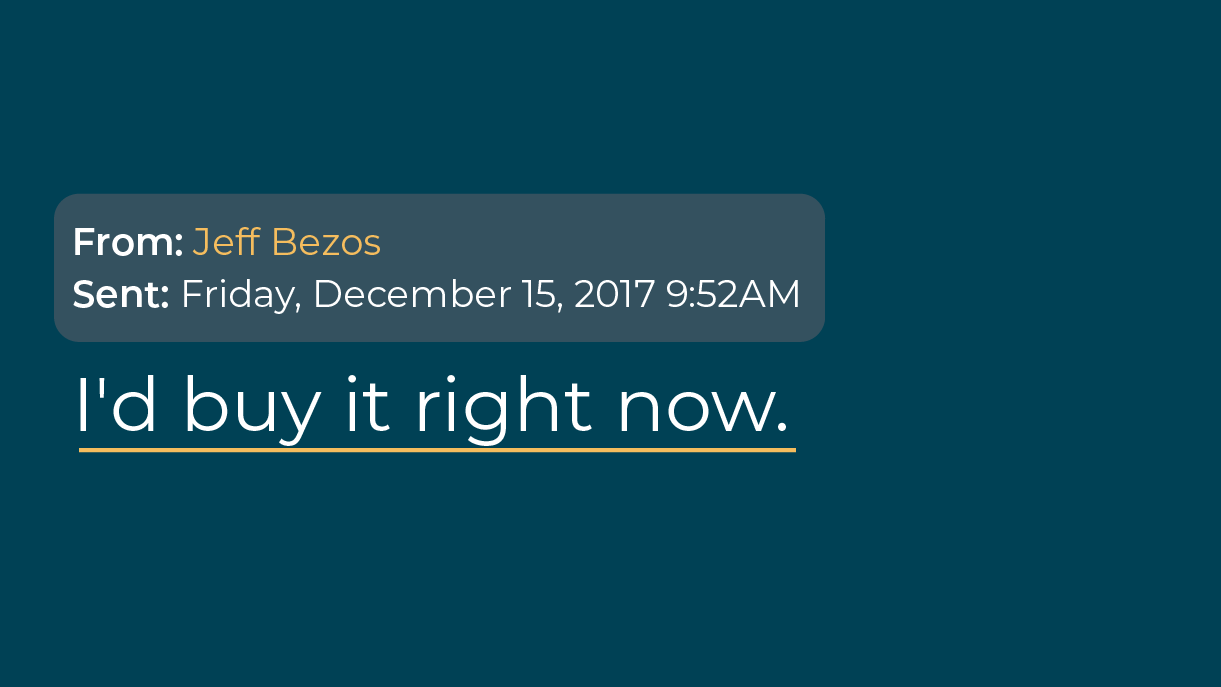How to Craft Executive-Level Points of View: Frameworks for Strategic Reps
This post is Part 2 of “Stuff sales leaders say that sounds helpful, but it’s just not.”
You can catch up on Part 1 here, which was all about being told to “Sell value!”
___________________
Ever had a sales leader tell you, “Bring a point of view?” If so, I agree. It’s what you should do.
The question is, what the heck’s a point of view? And how do you have one?
Well over 90% of sellers get this idea wrong.
Including reps spending hours researching execs. Because a POV isn’t about personalization.
(It has nothing to do with an executive’s career history, alma matter, or personal hobbies.)
It also has nothing to do with your product. Executives don’t think about your product.
Like, not at all. (They think about what they want to say to their board next month.)
Instead, a POV is a unique recommendation that backs an executive priority.
It’s a well-researched idea of how you’ll create value.
And it’s a skillset you’ll rely on while writing up a compelling business case.
How to Craft Point of View
Crafting a POV is about offering a credible recommendation for a complex problem.
Which happens by matching up a messy situation with a structured framework.
It’s also more of an ongoing process than a point-in-time task.
Your POV will change as you go deeper in discovery. Which means that, while you can craft an initial point of view with your account research, you’ll also want to develop the mental dexterity and business acumen to do this on the fly.
The best way I know how to do this?
“Case Interviews.”
The Greatest Sales Training I Never Had
I haven’t read 95% of the top sales books. I’ve never gone through a formal sales training.
Instead, I learned how to sell “by analogy.” Which isn't a new idea. In fact:

- Arnold Schwarzenneger took ballet to improve his transitions and movements while posing.
- Kobe Bryant took tap dancing lessons to strengthen his ankles and increase his coordination on the court.
I didn't know it at the time, but this concept started for me after I hit a point where I wasn't sure what I wanted to do with my career. I figured consulting would help me learn a lot and find out.
So I got a job building valuation models at a consulting firm, and to help me get that job, my roommate spent countless hours drilling me with mock “cases.”
In a single 90-minute sprint while sitting on our bunkbeds, we’d cover M&A recommendations, expanding market share, calculating fair market value, etc… which was like doing 9 or 10 high-level discovery calls and business case writing sessions, every single day.
Then, once I got that consulting job, I started building 100+ tab Excel models for massive enterprises. Which also forced me to structure and clarify my thinking.
It was easily the best sales training I never ever had, because it laid the foundation I continue to use while writing up business cases years later.
So now, what exactly is a “case?”
Cases are structured ways of building up a POV to guide executives. They work by:
- Giving you a small set of facts to start.
- If you ask the right questions, you get more data on the business problem.
- Then you match a framework to the situation, to understand what’s wrong and how to fix it.
- Next, you develop a concise set of recommendations.
- Finally, you lay it all out in a concise narrative.
This is the process of crafting a POV.
This is also why now, whenever I’m adding numbers into a business case, my brain is trained to think in terms of:
- Scenarios and sensitivities
- Dependencies and drivers
- Risks and tradeoffs
The 5 Most Common Frameworks to Structure Your Point of View
The workbook I used for all this practice is called Case in Point. Countless consultants train with it. Most sellers have never heard of it.
So here are 5 example consulting frameworks to draw on while crafting a POV.
If you can understand the basics of each, to match them up to the situation your prospect is in, you'll standout.
You can also read practice cases from BCG or Bain. And I’ll share a few examples of how these led me to the POV's in two recent business cases I wrote.
1/ Profitability Framework:
- Revenue: What drives each source of revenue, including price and quantity?
- Cost: What are the major cost components for each product line?
- Volume: Where and how much of each product line / services is sold?
- Competition: How is the competitive landscape impacting profitability?
2/ Market Entry Framework:
- Market Size: What’s the size of the target market?
- Market Growth: What’s the growth rate and potential of the market?
- Market Share: How much share can the customer actually achieve?
- Barriers to Entry: What obstacles or challenges are there for entering the market?
- Profitability: How profitable will entering the market be?
3/ Mergers and Acquisitions (M&A) Framework:
- Strategic Fit: How compatible are the two companies' strategies?
- Financials: How’s each performing? Will merging improve the financials?
- Market Factors: What market dynamics, competition, industry trends exist?
- Integration: What challenges / opportunities will integrating two companies bring?
- Risks: What risks will throw the process off track?
4/ Pricing Framework:
- Cost-Based Pricing: Analyze costs, then add a markup on top.
- Competitor-Based Pricing: Consider how much competitors are already charging, and how you can drive more differentiation.
- Value-Based Pricing: Based on the perceived value of the product / service to customers.
- Elasticity: Evaluate the price sensitivity of different customer segments.
5/ Market Sizing Framework:
- Top-Down Approach: Start with the total market size, then narrow into the target segment.
- Bottom-Up Approach: Estimate the # of potential customers + how much each will spend.
- Market Segmentation: Break down the market into relevant segments.
- Assumptions: Make a few logical assumptions to estimate market size.
- Cross-Verify: With estimates from different approaches or data sources.
Using Frameworks to Craft a Point of View
Here’s how these types of frameworks will impact how your point of view shows up when…
- Structuring a business case
- Framing a problem statement
- Asking questions during discovery
- Showing up in executive meetings
- Creating urgency for making a change
…using two examples from my own pipeline.
Profitability Framework: An HR Software Company
- Situation: The company’s working to command an attractive valuation during their next raise, and investors have been concerned with how quickly the company’s burning cash.
- Complication: The company just introduced a new product line focused on “Earned Wage Access.” Not all CFO’s are familiar with the concept, and HR teams struggle to message it clearly. That’s creating longer sales cycles and lower win rates, so reps avoid selling it.
- Recommendation: Shift the mix of revenue to the higher-margin Earned Wages product line, to drive more profitable growth, by enabling HR champions with a written business case that simplifies the new product line's messaging for CFO’s.
→ And yes, you guessed it.
Their sales team now uses Fluint to create and collaborate on the written business cases their HR champions present to Finance.
See how the message doesn’t have to directly focus on our product? But you can still see how it’s tied in? It’s about the project—shifting the mix of revenue—enabling an executive priority.
M&A Framework in the Customer Engagement Space
- Situation: Private equity acquired and merged three different customer engagement companies, to better compete against and take business from the industry giant.
- Complication: The one merged company is struggling to increase sales velocity. Reps stick to selling the product they’re used to, and when they branch out, their messaging focuses on the tech. There’s no standardized sales framework to unite the different teams, either.
- Recommendation: Drive top line growth to beat acquisition targets, by winning the most highly-competitive deals (which also bring the largest multiyear contracts) by introducing a standard, “value-based” business case framework for all reps to build from.
Becoming a Strategic Seller (Even If You’re Selling SMB)
Here’s my bigger point behind crafting a point of view in each deal.
Becoming a strategic seller is not about selling:
- With “Enterprise” or “Strategic” in your title
- Contract values with a lot of zeros in them
- Companies with > 1,000 employees
It’s about making this shift:
- Every Other Rep: Selling products that solve problems.
- Strategic Reps: Selling projects that support priorities.
So the next time you’re working on a business case, start with a point of view. Clarify what you think by using a solid framework. Then develop the project that enables an exec-level priority.
Why stop now?
You’re on a roll. Keep reading related write-up’s:
Draft with one click, go from DIY, to done-with-you AI
Get an executive-ready business case in seconds, built with your buyer's words and our AI.

Meet the sellers simplifying complex deals
Loved by top performers from 500+ companies with over $250M in closed-won revenue, across 19,900 deals managed with Fluint

Now getting more call transcripts into the tool so I can do more of that 1-click goodness.



The buying team literally skipped entire steps in the decision process after seeing our champion lay out the value for them.


Which is what Fluint lets me do: enable my champions, by making it easy for them to sell what matters to them and impacts their role.








